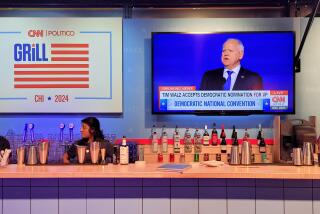News-Fangled Museum Opens
- Share via
Fancy museums and egotistical journalists have long been among the more prominent residents of our nation’s capital, so perhaps it was inevitable that the twain should meet in the form of--you guessed it--the Newseum, which opened Friday in this Washington suburb.
The 2 1/2-year, $50-million effort to launch the Newseum presumes that regular people want to know more about the behind-the-scenes world of the news media. That premise may be misguided, since a national survey commissioned by the Freedom Forum--the pro-free-press foundation, launched by USA Today founder Al Neuharth, that built the Newseum--found that most Americans distrust the news media and think journalists are about as ethical as lawyers and politicians. (More details of the survey are available at https://www.newseum.org.)
But never mind. The Newseum expects to lure several thousand visitors a week with a bevy of participatory high-tech attractions--and perhaps improve the profession’s image in the process.
Museum goers who yearn to be in front of a camera can pretend to be TV newscasters, reading the news off a real TelePrompTer with microphone in hand. Those who would rather be sportscasters can deliver the play-by-play of a baseball game in an actual sound booth. The Newseum will happily sell tapes of those performances for $10 a pop.
For the less glamorous newspaper business, the Newseum juices things up with an interactive game called “Be a Reporter/Be an Editor.” The game was filmed in the actual newsroom of USA Today--right across the street from the Newseum--but Shakespearean actors were hired to play the roles of key personnel at the fictional newspaper, the Daily Miracle.
(“You couldn’t do it with real reporters and editors because they’re just not very convincing, even when they’re playing themselves,” explained Joe Urschel, the Newseum’s deputy director.)
In the game, reporters investigate whether school lunches were made with spoiled cheese that sickened children. Players touch the screen to navigate around town, visiting sources at the cafeteria, hospital and town dump, among other places. Those who would rather be editors listen to story pitches, decide which ones to pursue and lay out the front page while working against a deadline.
When this reporter turned in her story after 15 minutes of play, she was berated by the electronic editor (“You call this a story!??”) for filing too hastily. Peter S. Prichard, who was editor in chief of USA Today for six years before becoming the Newseum’s executive director, said the average player must try three times before winning the editor’s praise.
Another interactive feature presents a real-life journalism ethics question, like whether to move dead Civil War soldiers to make a photo more dramatic, and whether to lie to gain access to family members of TWA Flight 800 crash victims. After players decide what they would do, they can find out how the episodes played out in real life (journalists did move the bodies and lie to talk to family members).
In most cases, it hardly endears visitors to the profession. But they can vent their frustrations at touch-screen “Polling Places.” At one station last week before the official opening, 37% of respondents rated the media’s work as “excellent” and an additional 41% rated it “good.” Only 5% said it was “poor.”
*
That probably reflects the fact that the Newseum’s advance visitor pool was weighted heavily with American Society of Newspaper Editors conference attendees and members of the Washington press corps and their families. In a troubling sign, even 36% of that crowd said their need for news is decreasing.
“I don’t know that we’ll single-handedly change people’s feelings about the media,” said Prichard. “But it would help for people to understand how news decisions are made.”
*
Karen Kaplan covers technology, telecommunications and aerospace. She can be reached via e-mail at Karen.Kaplan@latimes.com
More to Read
The biggest entertainment stories
Get our big stories about Hollywood, film, television, music, arts, culture and more right in your inbox as soon as they publish.
You may occasionally receive promotional content from the Los Angeles Times.










